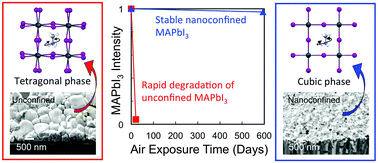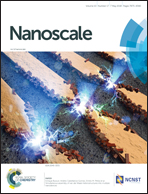Remarkable long-term stability of nanoconfined metal–halide perovskite crystals against degradation and polymorph transitions†
Abstract
Metal–halide perovskites are promising candidates to advance optoelectronic devices but are known to suffer from rapid material degradation. Here we demonstrate that nanoconfinement is an effective strategy for the long-term stabilization of metal–halide perovskite MAPbI3 crystals against humidity-induced degradation and temperature-induced polymorph transitions. Two-dimensional X-ray diffraction patterns of MAPbI3 films reveal an unprecedented air-stability of up to 594 days in non-chemically modified, non-passivated MAPbI3 films deposited on substrates imposing complete 2D confinement on the tens of nanometers length scale. Temperature-dependent X-ray diffraction analysis and optical spectroscopy further reveal the suppression of temperature-dependent phase transitions in nanoconfined MAPbI3 crystals. Most notably, the high-temperature cubic phase of MAPbI3, typically stable at temperatures above 327 K, remains present until a temperature of 170 K when the perovskite crystals are nanoconfined within the 100 nm diameter pores of anodized aluminum oxide templates. Photoluminescence mapping confirms that nanoconfined MAPbI3 crystals exhibit spatial uniformity on the tens of microns length scale, suggesting that nanoconfinement is an effective strategy for the formation of high-quality, stable MAPbI3 crystals across large areas.



 Please wait while we load your content...
Please wait while we load your content...
